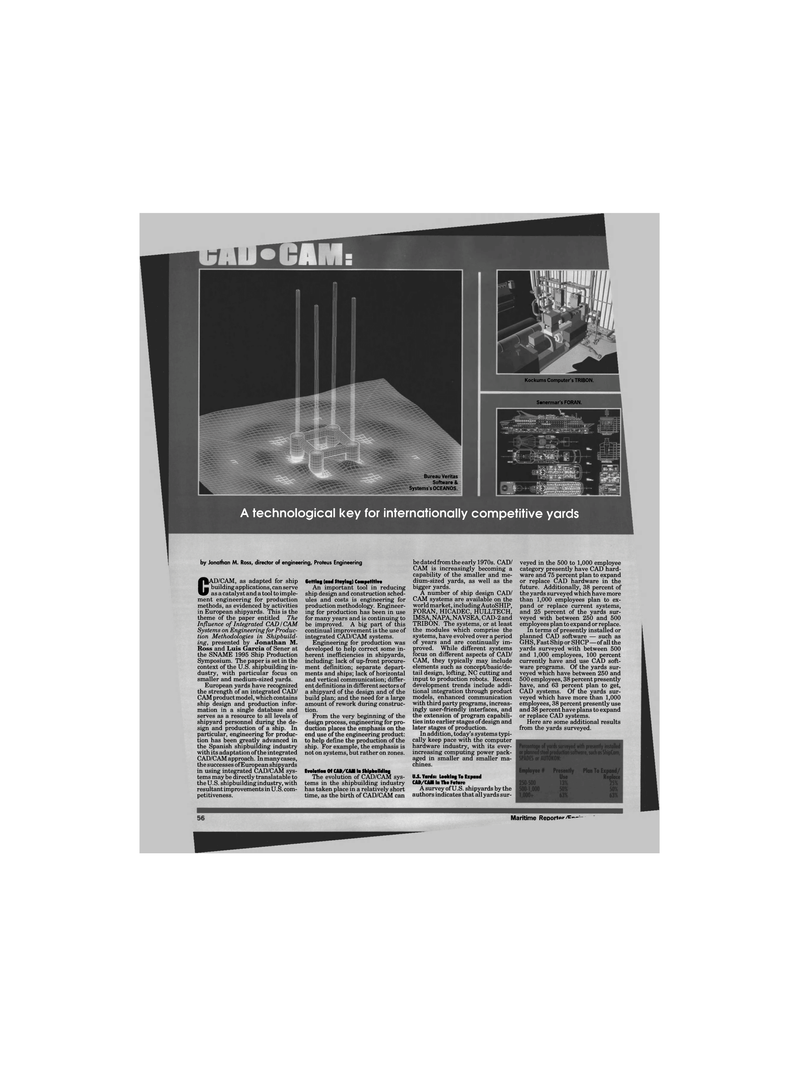
Page 54: of Maritime Reporter Magazine (July 1995)
Read this page in Pdf, Flash or Html5 edition of July 1995 Maritime Reporter Magazine
Bureau Veritas
Software &
Systems'sOCEANOS.
A technological key for internationally competitive yards be datedfrom the early 1970s. CAD/
CAM is increasingly becoming a capability of the smaller and me- dium-sized yards, as well as the bigger yards.
A number of ship design CAD/
CAM systems are available on the world market, including AutoSHIP,
FORAN, HICADEC, HULLTECH,
IMSA, NAPA, NAVSEA, CAD-2 and
TRIBON. The systems, or at least the modules which comprise the systems, have evolved over a period of years and are continually im- proved. While different systems focus on different aspects of CAD/
CAM, they typically may include elements such as concept/basic/de- tail design, lofting, NC cutting and input to production robots. Recent development trends include addi- tional integration through product models, enhanced communication with third party programs, increas- ingly user-friendly interfaces, and the extension of program capabili- ties into earlier stages of design and later stages of production.
In addition, today's systems typi- cally keep pace with the computer hardware industry, with its ever- increasing computing power pack- aged in smaller and smaller ma- chines.
U.S. Yards: Looking To Expand
CAD/CAM In The Future
A survey of U.S. shipyards by the authors indicates that all yards sur- veyed in the 500 to 1,000 employee category presently have CAD hard- ware and 75 percent plan to expand or replace CAD hardware in the future. Additionally, 38 percent of the yards surveyed which have more than 1,000 employees plan to ex- pand or replace current systems, and 25 percent of the yards sur- veyed with between 250 and 500 employees plan to expand or replace.
In terms of presently installed or planned CAD software — such as
GHS, Fast Ship or SHCP—of all the yards surveyed with between 500 and 1,000 employees, 100 percent currently have and use CAD soft- ware programs. Of the yards sur- veyed which have between 250 and 500 employees, 38 percent presently have, and 63 percent plan to get,
CAD systems. Of the yards sur- veyed which have more than 1,000 employees, 38 percent presently use and 38 percent have plans to expand or replace CAD systems.
Here are some additional results from the yards surveyed.
Maritime ReDortPr/c—
C^D/CAM, as adapted for ship building applications, can serve as a catalyst and a tool to imple- ment engineering for production methods, as evidenced by activities in European shipyards. This is the theme of the paper entitled The
Influence of Integrated CAD I CAM
Systems on Engineering for Produc- tion Methodologies in Shipbuild- ing, presented by Jonathan M.
Ross and Luis Garcia of Sener at the SNAME 1995 Ship Production
Symposium. The paper is set in the context of the U.S. shipbuilding in- dustry, with particular focus on smaller and medium-sized yards.
European yards have recognized the strength of an integrated CAD/
CAM product model, which contains ship design and production infor- mation in a single database and serves as a resource to all levels of shipyard personnel during the de- sign and production of a ship. In particular, engineering for produc- tion has been greatly advanced in the Spanish shipbuilding industry with its adaptation of the integrated
CAD/CAM approach. In many cases, the successes of European shipyards in using integrated CAD/CAM sys- tems may be directly translatable to the U.S. shipbuilding industry, with resultant improvements inU.S. com- petitiveness.
Getting (and Staying) Competitive
An important tool in reducing ship design and construction sched- ules and costs is engineering for production methodology. Engineer- ing for production has been in use for many years and is continuing to be improved. A big part of this continual improvement is the use of integrated CAD/CAM systems.
Engineering for production was developed to help correct some in- herent inefficiencies in shipyards, including: lack of up-front procure- ment definition; separate depart- ments and ships; lack of horizontal and vertical communication; differ- ent definitions in different sectors of a shipyard of the design and of the build plan; and the need for a large amount of rework during construc- tion.
From the very beginning of the design process, engineering for pro- duction places the emphasis on the end use of the engineering product: to help define the production of the ship. For example, the emphasis is not on systems, but rather on zones.
Evolution Of CAD/CAM In Shipbuilding
The evolution of CAD/CAM sys- tems in the shipbuilding industry has taken place in a relatively short time, as the birth of CAD/CAM can
Kockums Computer's TRIBON.
Senermar's FORAN. by Jonathan M. Ross, director of engineering, Proteus Engineering

 53
53

 55
55
